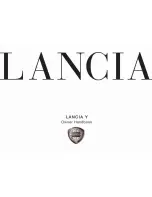
10 Maintenance and service
10
355
NOTE
If the battery has become so discharged
that everything is "black" and in principle
the car does not have all the normal elec-
trical functions and the engine is subse-
quently started using an external battery or
battery charger, then the Start/Stop func-
tion will be activated. It will then be possi-
ble for the engine to be auto-stopped but
in the event of an auto-stop the Start/Stop
function may fail to auto-start the engine
due to inadequate capacity in the battery.
The battery must first be charged in order
to ensure a successful auto-start after an
auto-stop. At an outside temperature of
+15 °C the battery needs to be charged for
at least 1 hour. At a lower outside tem-
perature a charging time of 3-4 hours is
recommended. The recommendation is
that the battery is charged using an exter-
nal battery charger.
If this is not possible then the recommen-
dation is to temporarily deactivate the
Start/Stop function until the battery has
been adequately recharged.
For more information on charging the
starter battery, see Starter battery (p. 351).
Related information
•
Battery - symbols (p. 352)
Fuses - general
All electrical functions and components are
protected by a number of fuses in order to
protect the car's electrical system from dam-
age by short circuiting or overloading.
If an electrical component or function does
not work, it may be because the component's
fuse was temporarily overloaded and failed. If
the same fuse fails repeatedly then there is a
fault in the circuit. Volvo recommends that
you visit an authorised Volvo workshop for
checking.
Changing
1. Look in the fuse diagram to locate the
fuse.
2. Pull out the fuse and check from the side
to see whether the curved wire has
blown.
3. If this is the case, replace it with a new
fuse of the same colour and amperage.
WARNING
Never use a foreign object or a fuse with
an amperage higher than that specified
when replacing a fuse. This could cause
significant damage to the electrical system
and possibly lead to fire.
Location, fuse boxes
Fuse box locations in a left-hand drive car. In
a right-hand drive car the fuse box under the
glovebox changes sides.
Engine compartment
Under the glovebox
Below right front seat
Related information
•
Fuses - in engine compartment (p. 356)
•
Fuses - under glovebox (p. 359)
•
Fuses - under right front seat (p. 362)
Summary of Contents for V 40
Page 1: ...WEB EDITION OWNER S MANUAL...
Page 2: ......
Page 15: ...Table of contents 13...
Page 16: ...INTRODUCTION...
Page 25: ...SAFETY...
Page 55: ...INSTRUMENTS AND CONTROLS...
Page 57: ...03 Instruments and controls 03 55 Overview left hand drive cars...
Page 60: ...03 Instruments and controls 03 58 Overview right hand drive cars...
Page 94: ...03 Instruments and controls 03 92 Templates for halogen headlamps...
Page 127: ...CLIMATE CONTROL...
Page 147: ...LOADING AND STORAGE...
Page 160: ...LOCKS AND ALARM...
Page 186: ...DRIVER SUPPORT...
Page 265: ...STARTING AND DRIVING...
Page 313: ...WHEELS AND TYRES...
Page 333: ...MAINTENANCE AND SERVICE...
Page 372: ...AUDIO AND MEDIA...
Page 439: ...SPECIFICATIONS...
Page 469: ...12 Specifications 12 467 Country Area Taiwan...
Page 477: ...12 Specifications 12 475...
Page 490: ...13 Alphabetical Index 13 488...
Page 491: ......
















































